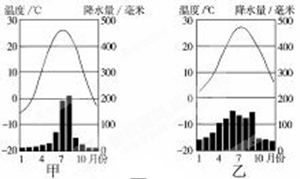京沪高速铁路2011年6月30日正式通车,它的建成使北京和上海之间的往来更加便利。读图,回答下列问题。(9分)

(1)京沪高铁纵贯了我国三大直辖市和 、鲁、苏、 四省(填简称)。
(2)京沪高铁连接的我国两大工业基地是 、 。
(3)下图为北京、上海的气温曲线和降水柱状图,其中代表上海的是 图,据图描述两城市在气温和降水方面的差异 。 
9分
(1)冀 浙 2分
(2)京津唐工业基地;沪宁杭工业基地 2分
(3)乙 1分 气温:冬天北京月均气温处在0℃以下而上海则在0℃以上,北京气温比上海气温低。2分 降水:北京降水多集中在夏季,上海集中在4——9月,且北京年降水量比上海小。2分
题目分析:(1)京沪高铁纵贯了我国三大直辖市和冀(河北省)、鲁(山东省)、苏(江苏省)、浙(浙江省)四省。(2)京沪高铁连接的我国两大工业基地是京津唐工业基地;沪宁杭工业基地。(3)下图为北京、上海的气温曲线和降水柱状图,其中代表上海的是乙图,两城市在气温和降水方面的差异为气温方面冬天北京月均气温处在0℃以下而上海则在0℃以上,北京气温比上海气温低。降水方面北京降水多集中在夏季,上海集中在4——9月,且北京年降水量比上海小。
点评:本题还可以考查我国交通线路,主要的铁路干线;我国内海分别为渤海与琼州海峡;我国行政区划的辽宁省与山东省既临渤海又临黄海;华北平原;我国地势的第三级阶梯;我国气候类型中的温带季风气候与亚热带季风气候及其特征等相关知识。
